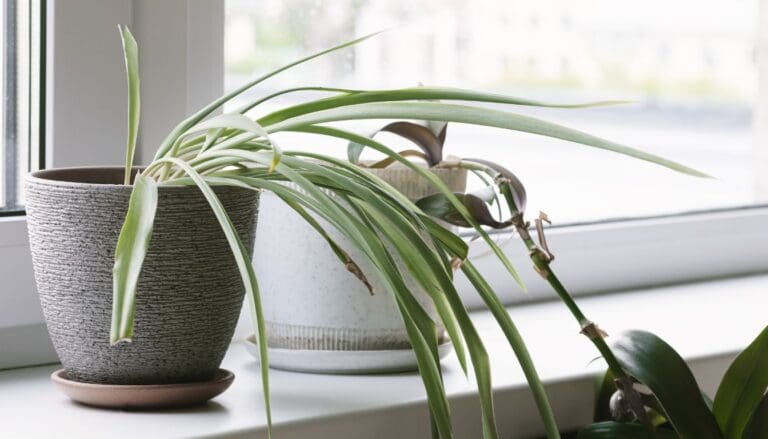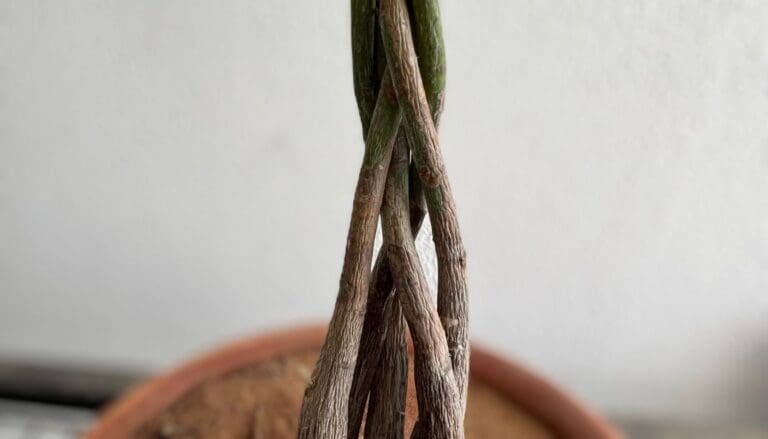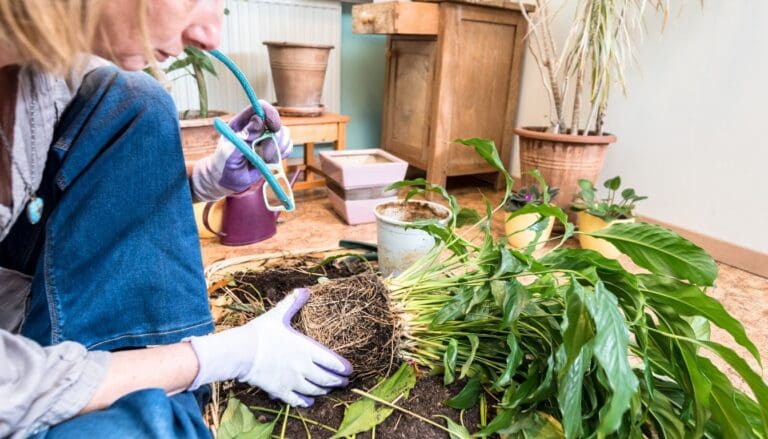Do Crotons Need Misting? (+Maintaining Ideal Humidity)
Crotons are popular houseplants known for their wide varieties of multicolored leaves. They come from the pacific and tropical Asia, where they get warm climate and humid conditions. Since misting is a way of providing humidity, you might wonder if your Crotons would like it.
So, in this article, we shall understand do crotons need misting.
Crotons should only be misted if you keep them in a dry environment. Crotons prefer a humidity range of between 50-80%, so if the humidity level is below that, you can mist them 3-4 times a week. Avoid misting in humid conditions as it can lead to pest infestation and fungal diseases.
Misting keeps the leaves healthy and moisturized. Regular misting, keeping a pebble tray, using a humidifier are some ways to increase humidity around the plant.
If the surrounding area already has high humidity, you should avoid misting, increasing the risk of pest infestation and fungal diseases.
This article will discuss the pros and cons of misting your crotons and how you can maintain the proper humidity level around them.

Please note: Simplify Plants is reader-supported. Some links in the post are affiliate links and I get a commission from purchases made through links in the post.
Do crotons like humidity?
Coming from humid tropics, Crotons appreciate a warm and humid environment. They are native to tropical jungles with moist air and high temperatures. When grown as a houseplant, they need enough humidity to maintain healthy growth.
But there might be a question: how humidity affects croton’s growth? Why is humidity so essential for them? Let us understand this.
We all know that plants cook their food through the process of photosynthesis. They need air, water, minerals, and sunlight for photosynthesis. They take up air and moisture through tiny pores present in leaves called stomata.
Plant transpires through stomata, and when humidity levels are high, plants open up the pores in the leaf surface to absorb air and water for photosynthesis.
But if humidity levels are low and the plant opens the pores for transpiration, they will lose much water.
They avoid transpiration to conserve water for survival. Due to lack of transpiration, they won’t be able to perform enough photosynthesis to prepare their food, reducing the growth.
How much humidity do crotons need?
Crotons prefer high humidity levels. They are tropical plants native to Southeast Asia, Malaysia, India, and the Pacific, where the humidity ranges around 80%.
Although as an indoor plant, they can survive with a minimum humidity level of around 40-50%. If you want your crotons to grow and thrive, maintain a humidity level of 60%.
Make sure that the humidity level doesn’t fall below 40%. Crotons will do best when they get ideal room temperatures accompanied by high humidity levels.
Do Crotons like to be misted?

Yes, Crotons like to be misted if the humidity around them is low. Their native regions have warm climates and humidity levels of around 80%. So Croton’s care is highly associated with humidity.
Crotons in the home will not get humid conditions like their native place, but you can add as much humidity to make them feel better and healthy. You must maintain a humidity level above 40% in homes.
You can take many steps to increase the humidity. Misting is one the simplest ways to increase instant humidity. Misting is the process of sprinkling tiny droplets of water on both sides of leaves with a spray bottle.
You should continuously mist in the morning, so the leaf gets enough time to dry. You can mist your plant multiple times per week according to its moisture requirement.
But if the surrounding is too dry, you cannot just depend on misting. You need to follow some other methods to increase humidity for your Croton.
Also, if the surrounding is too humid and does not have proper airflow, then misting can make a blunder to your plant. Misting in humid conditions increases the risk of pest infestation as pests like humidity keep themselves moist.
How often should you mist your Crotons?
Misting is one of the easiest ways to help your Croton get the moisture they need. Generally, misting 3-4 times a week will keep moisture optimum. Misting once a week also works great for your plant.
But if the weather around your Croton is hot and dry during the day, you may need to mist your plant once a day.
If humidity levels are too low, you can look for other methods as misting alone won’t help much. Along with misting, you can use a pebble tray to add extra moisture to your plant.
For this, fill a tray with some pebbles and water. Then place your crotons over the pebbles. The water present in them will start to evaporate, creating a humid environment for your plants.
How to mist your Crotons?
To mist your Crotons:
- Take a spray bottle or a container and fill it with warm water.
- Start misting your plant, especially in the morning time.
- Mist both the top and the underside of your Croton’s leaves.
I prefer misting the plant early in the morning as, during this time, the plant opens its pores which allow water to absorb into the plant. You will notice dew on the leaves after you misted them.
Make sure that you keep your Crotons away from heating appliances, air conditioners, and drafty windows, as all these things will make the air dry.
How to check the humidity level of your room?

You can check the room’s humidity by using a device called a hygrometer. It helps with the exact humidity level of your room.
Different places in your house have different humidity levels. Places like kitchen bathrooms are more humid than bedrooms and drawing areas. In winters, the humidity level is much lower than in summers.
Therefore you can use a hygrometer to determine the right place for your crotons. Hygrometers are available at affordable rates, and you can get one online.
How do I know that my Crotons need humidity?
Since crotons are tropical plants, they need higher levels of humidity. If they don’t get sufficient humidity, they will show some signs:
- The leaves will wilt and droop.
- The leaves will become curly and crispy to touch.
- Leaf scorching.
- The leaves will start to turn yellow.
- The leaves will start to get brown edges.
These are the common signs your plant shows if humidity is a problem. Most of the problems often indicate other issues, too, so you need to analyze the signs and find out the actual cause carefully.
How to increase humidity for Crotons?
If you stay in a low humidity area, misting will not fulfill your crotons’ moisture requirements. You need to try other effective methods.
Let us now consider some ways to increase the humidity for your plant that works excellent for crotons.
Use a pebble tray
Using a pebble tray is one of the easiest ways to add extra moisture to the leaves. For this, you will need materials such as a tray, some pebbles, and water.
Fill the tray will pebbles and water; make sure that the pebbles are slightly above the water. Place your potted crotons over the pebble tray.
After some time, the water will evaporate, and the moisture generated will absorb the leaves.
Add a humidifier

One of the most preferred and convenient options for increasing the humidity level for your Crotons is using a humidifier device. It instantly increases the humidity levels in the room and stays longer in the environment.
You can set the ideal humidity level as per your plant’s needs by using a humidifier. Buy a high-quality humidifier that matches your room’s size.
You can get one online, and while searching, you can look for portable humidifiers.
Lower your room’s temperature
One technique to raise humidity is by lowering the room’s temperature. Facts say that the moisture level in cold air is more than in warm air.
If you bring the temperatures down, the room’s humidity level will increase.
If you’re from a low humidity zone, you can lower the temperature of your room so that your crotons get some moisture.
Add a mini greenhouse
You can add a mini greenhouse that holds moisture around your Croton. In a low humid area, a mini-greenhouse can be used to add humidity to your plant.
This little greenhouse made of glass or plastic not only raises humidity for your plant but also adds decor options to your room.
You can check out a mini-greenhouse online. For crotons, a small glass box works greats for providing ideal humidity conditions.
Use an aquarium
A small or medium-sized aquarium in your house can solve the humidity problem of your Croton. You can keep the aquarium in the same room where your plant is present.
As the water from the aquarium evaporates, it adds moisture to the air that increases the humidity level of your room.
Aquarium creates a pleasant surrounding for your crotons to thrive. Also, you can use the aquarium’s water to water your present. Aquarium water is a healthy drink for the Crotons as it is rich in nitrogen and minerals.
Group crotons with other houseplants

One way to increase humidity for crotons is by grouping them with other houseplants. The concept behind grouping is to encourage transpiration.
Transpiration happens when a plant releases excess moisture in the air through stomata. If we group many houseplants, all the plants will add moisture in the air by transpiration, which will raise the humidity level of the area.
Make sure you group your humid-loving plants and not the plants that need less humidity. Keeping them together will create a problem.
Use a moss pole
You can use a moss pole to increase humidity around your Crotons. A moss pole will mimic your plant’s natural environment to some extent by giving humidity and micronutrients.
A moss retains water, which later evaporates and creates a humid environment for the plants. Moss also supports your plant, and it helps the plant develop its aerial roots.
How does misting help your Crotons?
There are numerous reasons due to that you should mist your Crotons. Some of the reasons are:
- Misting is an effective way of boosting humidity around the plant. Misting adds moisture into the air that helps to make the surroundings humid.
- Misting keeps the plant cool and its leaves hydrated. Misting is essential during hot summers to help plants reduce stress.
- Misting keep the leaves clean by preventing dust accumulation. A clean and healthy leaf will be able to perform photosynthesis better.
- Misting also increases the moisture level of the soil.
- Neem oil can be added to water while misting. You can spray the neem oil solution over the plant to prevent pests and diseases from entering your plant.
What happens when you do excessive misting?

An excess of anything isn’t good. Excess care of your crotons often harms them. Misting without paying attention to the humidity can damage your plant.
Excessive misting can harm your crotons in the following ways:
- Misting does not help in the long run. If the surrounding region of the plant is always dry, then misting is of no use. You need to look for other ways to increase the humidity around crotons.
- If the surrounding region around the plant is already humid, then misting will add more moisture to the air, which will attract pests and diseases towards the plant.
- Excessive misting will keep the leaves wet for longer periods. Wet leaves will become perfect for fungi and pests to grow.
- Misting frequently will damage the leaf surface. Wet leaves will fail to transpire and won’t perform photosynthesis.
Final words
Crotons are humidity-living plants, and they like getting misted to some extent, but it won’t help them in the long run.
In a dry region, you need to look for other ways to raise the humidity, such as installing a humidifier or using a pebble tray or mini-greenhouses.
Over-misting is harmful to crotons as it will attract pests and diseases and damage the leaves. So don’t take misting as the only option to raise humidity but do it for cleaning the leaf surfaces for keeping the Plants cool.
Keep your Crotons away from heating appliances, air conditioners, and cold drafts, as all these reduce the humidity levels around the plant. Take care of their humidity, temperature, and other factors to make your crotons thrive.
Reference: Sciencedirect, Wikipedia, Wikipedia, Britannica, CABI, Academia, University of South Florida, The University of Georgia.
Recommended Garden Supplies
| Product Image | Our Recommended Gardening Supplies | Check Offers! |
|---|---|---|
Top Top
Top
Top
Top
Top
Top
Top
Top | rePotme Houseplant and Tropical Classic Potting Soil Mix | Check Offer On Amazon |
 Top
Top
Top
Top
Top
Top
Top
Top | Espoma Organic Indoor Plant Food | Check Offer On Amazon |
 Top
Top
Top
Top
Top
Top
Top
Top | GooingTop LED Grow Light 6000K Full Spectrum Clip Plant Growing Lamp | Check Offer On Amazon |
 Top
Top
Top
Top
Top
Top
Top
Top | Soil Moisture Meter | Check Offer On Amazon |
 Top
Top
Top
Top
Top
Top
Top
Top | Govee Hygrometer Thermometer, Bluetooth Enabled! | Check Offer On Amazon |
 Top
Top | LEVOIT Humidifiers for Large Room(Best For Plants) | Check Offer On Amazon |
 Top
Top
Top
Top
Top
Top
Top
Top | Upgraded DIY Automatic Drip Irrigation Kit, 15 Potted Houseplants Support | Check Offer On Amazon |
 Top
Top
Top
Top
Top
Top
Top
Top | Stainless Steel Heavy Duty Gardening Tool Set | Check Offer On Amazon |
 Top
Top
Top
Top
Top
Top
Top
Top | Bonide Insecticidal Soap | Check Offer On Amazon |
 Top
Top
Top
Top
Top
Top
Top
Top | Bonide 32 oz Spray Neem Oil for Organic Gardening | Check Offer On Amazon |
 Top
Top
Top
Top
Top
Top
Top
Top | Garden Safe Fungicide | Check Offer On Amazon |






